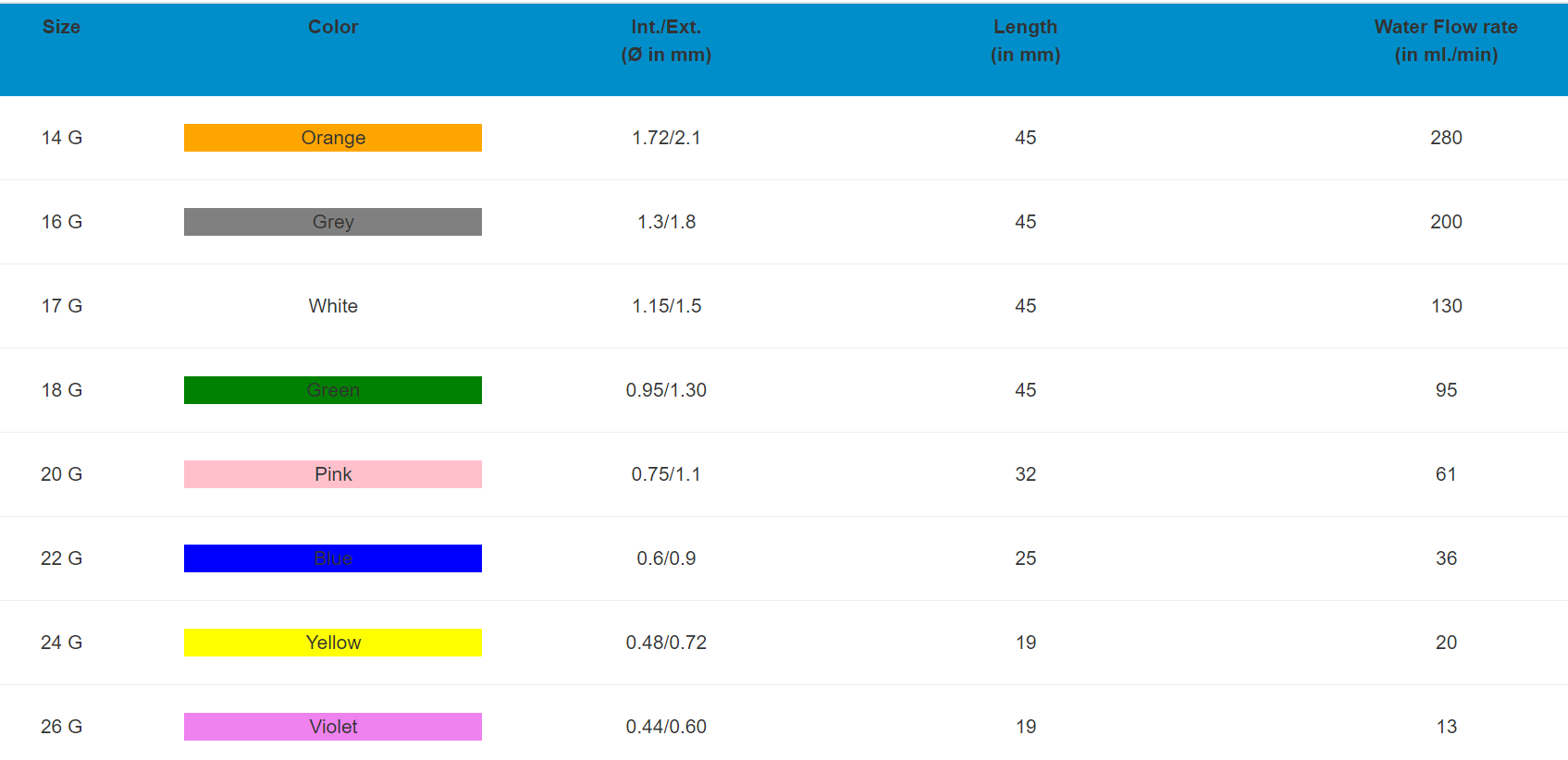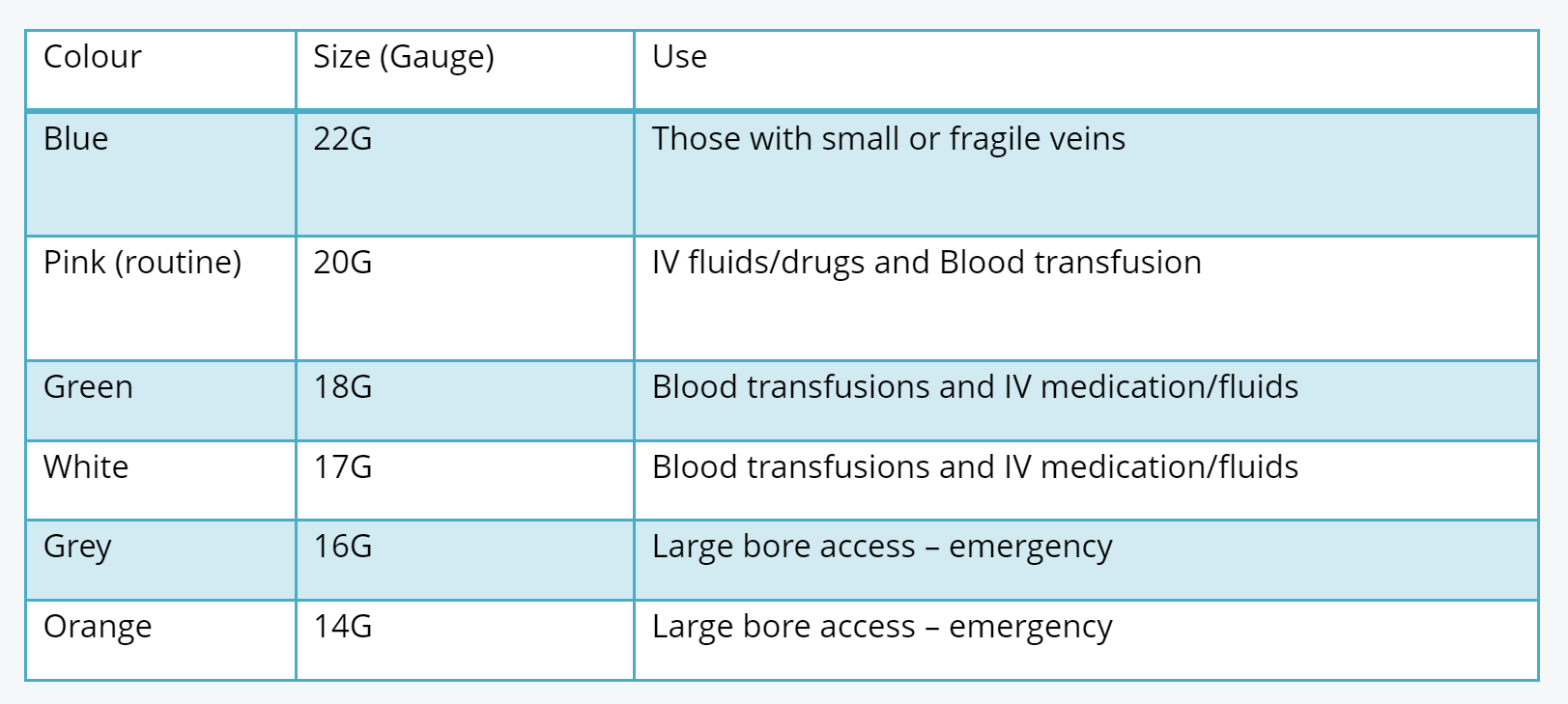In this article, the procedure of IV cannula insertion will be discussed followed by IV cannula size and colour coding discussion.
The technique and procedure of IV cannula insertion
Intravenous (IV) cannulation is a technique in which the doctor or nurse places a small plastic tube, very small, very thin such that it enters the vein easily.
It is also known as (venflon or cannula) which is inserted into a patient’s vein to provide venous access.
What is the need to insert cannula into the patient’s vein?
The patient’s vein is a very easy route other than the normal and natural gastrointestinal tract to administer drugs and fluids into the body of the patient.
In situation where the patient is not able to eat or drink, we have to insert cannula into the vein to have an access into the bloodstream of the patient.
The examples of such situations are:
Unconscious state,
Excessive vomiting,
Acute severe illness where drugs are needed to work rapidly without any delay,
Emergency situations like resuscitation,
Hospitalised patients,
In situations where drugs are available only in injectable form, Eatable or orally administered form of the drug is not available,
When blood transfusion is required.
Indications of IV cannula insertion
All the above situations listed under the heading of indications of IV cannulation. Let me write that once more for you:
Unconscious state,
Excessive vomiting,
Acute severe illness where drugs are needed to work rapidly without any delay,
Emergency situations like resuscitation,
Hospitalised patients,
In situations where drugs are available only in injectable form, Eatable or orally administered form of the drug is not available,
When blood transfusion is required.
This is one the main basic skills that is required by the junior resident or an intern.
It is a very crucial skill and should be mastered by every healthcare professional. Also, it is often asked in the exams and practical exams and viva.
Contraindications of IV cannula
No consent not given by the patient because of apprehension or any other reason,
Local infection over the tissue where iv cannula has to be placed,
Sometimes by mistake, under-trained nurses may put iv cannula into the AV fistula of the patients who are undergoing haemodialysis for chronic kidney disease,
AV fistulas are a strong contraindication to place a regular iv cannula.
Equipments required for insertion of an IV cannula
Properly fitting gloves. You can always add a double pair of gloves because in countries like India, many patients are HIV or HCV or HBsAg positive and are not diagnosed and sometimes these patients do not tell the healthcare professional about the disease. So, always consider the patient to be somewhat positive (HIV, HCV or HBsAg) and take extra precaution before inserting an IV cannula.
We will require a tourniquet to create a resistance to the blood flowing back. This will make the distal veins engorged and easy to see and palpate and insert the IV cannula.
A spirit swab for sterilising the local site to decrease the chances of infection.
The required or intended IV cannula for the kind of patient, underlying disease and the status of the visibility of the vein.
Syringe for flushing the cannula with saline to check the patency
A bin which is dedicated to sharps or a needle burner
Tape or dressing for fixing the iv cannula (easy fix)
Introduction with the patient and explanation of the procedure
Wash hands
Wash hands using the proper Ayliffe technique
Your introduction to the patient
You must introduce yourself to the patient in a calm and composed manner and must inform the patient about the procedure to are going to conduct.
“hello/namaskar, I am Dr. Singh and i am going to put an IV cannula into your vein”
Enquire about the patient to verify his/her identity
Patient must be verified once again before performing the procedure so that the chances of misunderstanding are minimal.
Tell the patient about the procedure you are going to conduct on the patient once again.
Take verbal consent by confirmation from the patient
May I proceed with the procedure if it is okay with you?
Before the procedure
You have to choose and examine the non-dominant hand for iv cannulation.
Make proper position of the arm
Take the equipment handy after putting on the gloves
Procedure of IV cannula insertion
Take 10 mL syringe and load it with saline
Apply the tourniquet and look for the direction of the vein
Swab the skin with spirit to make it sterile.
Tightly hold the skin with non-dominant hand.
Tell the patient about the little ‘sharp scratch’ as a warning and proceed gently with the cannula with needle bevel up into the skin at 20 degrees.
Look for blood at the base of the cannula which appears as a reddish hue which means iv cannula is in the vein itself.
Now, you can pull the trocar and the proceed further by gentle pushing the cannula into the vein until it is completely inside the vein.
End of Procedure
Thank the patient for his/her time and tell him/her that you have successfully inserted the cannula inside. You should always thank the patient and offer him/her further help for a nice dressing. This way, a rapport is built and the patient will not deny you any kind of procedure the next time you do it.
Putting down notes in the file
Now it is time that you label over the dressing of the patient the date and time of insertion of cannula along-with your signature.
Putting down proper notes in the file is also important. Many hospitals have a routine of sticking down the cannula stickers into the file.
Complications of IV thrombectomy and IV cannula insertion
Sometimes cannula does not enter the vein and it enters the subcutaneous tissue. It gives the patient unnecessary pain and it destroys the tip of the cannula also.
Sometimes cannula punctures the vein and a local hematoma form over there locally.
Cellulitis or thrombophlebitis is a very common complication especially in government hospitals in India. It occurs 2-3 days after IV cannula insertion or thrombotomy of any kind and is accompanied by fever, redness and pain locally over the site of insertion.
Some suggestions before IV cannula insertion
Do not insert the cannula at joints because it is very uncomfortable for the patient and also, it stops working in short period of time.
You can always use lignocaine jelly locally at the tentative puncture site to reduce the pain while the procedure.
It is easier to draw blood at the time of cannulation as it prevents unnecessary punctures afterwards for drawing blood.
Remove IV cannula reinsert it if it does not work or a local bleb form at the site of insertion.
If the skin becomes reddish, tender or swollen, you must suspect thrombophlebitis and immediately give broad spectrum antibiotics and antipyretics.
“Read about IV cannula size and colour coding below”
IV cannula Size and Colour Coding

What is a pediatric cannula?
It is a cannula for pediatric patients which is specially designed for neonates. It has projections on the wings and body. These projections help in easy cannulation and secure fixation.
It has a special flash-back chamber. It is made for easy visualisation of back flowing blood into the vein for confirmation of right placement of the catheter.
Its size is either 24G or 26G.
“Read about IV cannula size and colour coding below”
IV cannula Size and Colour Coding

This image shows IV cannula sizes and colour coding alongwith their lengh and flow rate. The violet cannula is the thinnest one and the orange cannula is the most wide bore cannula.
IV cannula Size and Colour Coding

The different IV cannula and colour coding is explained below
26G IV cannula size and colour coding as violet and is used in neonates.
24G IV cannula size and colour coding as yelow and is used in small or fragile veins. It is mostly used in pediatric patients.
22G IV cannula size and colour coding as blue. It is used for small and fragile veins and is used in adult patients with difficult veins.
20G IV cannula size and colour coding as pink. It is most commonly used cannula in routine and is also used for blood transfusion.
18G IV cannula size and colour coding as green. It is better used for blood transfusion and other routine purposes.
16G IV cannula size and colour coding as grey and is a wide bore cannula. it is used for large bore access in emergency situations for resuscitation.
14G IV cannula size and colour coding as orange. This is also a wide bore cannula and is used for access in emergency situations as in 16G grey coloured cannula.
This latter section of the article is about IV cannula size and colour coding. I hope the visitors have read through the article carefullay and have learned something meaningful. That is all, Thank You. Happy reading!!!
